Assignment:
Question 1. A ball of mass 0.4 kg, initially at rest, is kicked directly toward a fence from a point 20 m away, as shown below.
The velocity of the ball as it leaves the kicker's foot is 17 m/s at angle of 53 ? above the horizontal. The top of the fence is 7 m high. The kicker's foot is in contact with the ball for 0.03 s. The ball hits nothing while in flight and air resistance is negligible.
The acceleration due to gravity is 9.8 m/s2.
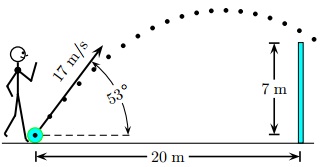
Determine the magnitude of the average net force exerted on the ball during the kick.
Question 2. Determine the time it takes for the ball to reach the plane of the fence.
Question 3. How far above the top of fence will the ball pass?
Question 4. What is the vertical component of the velocity when the ball reaches the plane of the fence?
Question 5. A ship maneuvers to within 2.45 × 103 m of an island's 1.76 × 103 m high mountain peak and fires a projectile at an enemy ship 6.07 × 102 m on the other side of the peak, as illustrated. The ship shoots the projectile with an initial velocity of 2.53 × 102 m/s at an angle of 73.2?.
The acceleration of gravity is 9.81 m/s2.
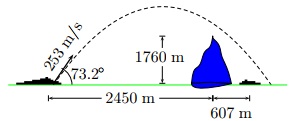
Note: Figure is not drawn to scale
a) How close to the enemy ship does the projectile land?
Question 6. b) How close (vertically) does the projectile come to the peak?
Question 7. A target lies flat on the ground 7 m from the side of a building that is 10 m tall, as shown below.
The acceleration of gravity is 10 m/s2. Air resistance is negligible.
A student rolls a 7 kg ball off the horizontal roof of the building in the direction of the target.
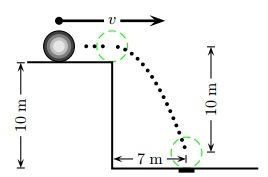
The horizontal speed v with which the ball must leave the roof if it is to strike the target is most nearly
1. v =√5/7 m/s.
2. v = 7√3 m/s.
3. v = 7√5 m/s.
4. v = 7√3/3 m/s.
5. v = 3√7 m/s.
6. v = 7√2/2 m/s.
7. v = √2/7 m/s.
8. v = 2√7 m/s.
9. v = 7√2 m/s.
10. v = √3/7 m/s.
Question 8. A bomber flies horizontally with a speed of 124 m/s relative to the ground. The altitude of the bomber is 4460 m and the terrain is level. Neglect the effects of air resistance.
The acceleration of gravity is 9.8 m/s2 .
a) How far from the point vertically under the point of release does a bomb hit the ground?
Question 9. b) At what angle from the vertical at the point of release must the telescopic bomb sight be set so that the bomb hits the target seen in the sight at the time of release?
Question 10. A 0.98 kg rock is projected from the edge of the top of a building with an initial velocity of 12.4 m/s at an angle 60? above the horizontal.
The building is 7.39 m in height.
Assume: The ground is level and that the side of the building is vertical. The acceleration of gravity is 9.8 m/s 2 .
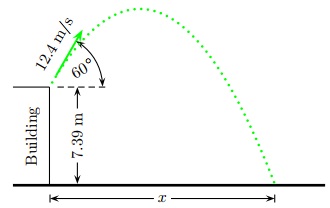
At what horizontal distance, x, from the base of the building will the rock strike the ground?
Question 11. A golf ball is hit at ground level. The ball is observed to reach its maximum height above around level 8.8 s after being hit. 0.73 s after reaching this maximum height, the ball is observed to barely clear a fence that is 381 ft from where it was hit.
The acceleration of gravity is 32 ft/s2 .
How high is the fence?
Question 12. Neglect: Air friction.
Your teacher tosses a basketball. The ball gets through the hoop (lucky shot).
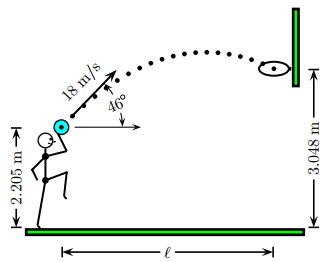
How long does it take the ball to reach its maximum height?
Question 13. How long does it take the ball to reach the hoop?
Question 14. What is the horizontal length l of the shot?